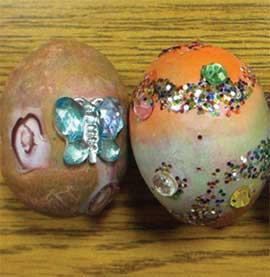Masks Masks are an important art form and a special part of rituals in cultures around the world, such as in some Día de Muertos celebrations in Mexico, and the theatrical tradition of Noh in Japan. Materials:
Petroleum jelly or plastic wrap Plaster gauze (the stuff they use for casts) Scissors Bowl (for water) Water Newspaper or plastic drop cloth Smock or old clothing Paints String or elastic if desired
IMPORTANT NOTES: This is a very messy and time-consuming craft. Two people are required—one to be the model for the face of the mask and one to make the mask. It works well with partners so that each person may have a mask. You can complete a full mask, a half mask, a mask with covered or open eyes and masks with covered or open mouths. Be sure to consider an air hole. If covering the mouth, leave the nose open. If you wish to have a solid mask with no openings, leave the nose open and cover it after the mask is removed from the face of the model. Instructions:
Activities
50
Prepare your working surface by putting down a drop cloth or newspaper. A sturdy table or counter is best. Both people should put on a smock or old clothing (this is messy stuff). Prepare the mask model’s face. This can either be done with petroleum jelly or plastic wrap. If using petroleum jelly, cover the entire area that will be covered by the plaster gauze. Test for allergies prior to making the mask and remember to completely remove the jelly after you complete your mask. Be sure to apply jelly very heavily in areas where there is hair (upper lip, eyebrows, hairline). If the model has long hair, tie it back really well before beginning. If using plastic wrap (this can be less messy but more risky), cut a large piece (big enough to cover the entire work area and the top of the hair) and make breathing holes. It will be tricky as you start to keep the breathing holes lined up. Be sure to check on them regularly. Cut the plaster gauze in strips and chunks. Think about smaller pieces for areas like under the nose and larger pieces for areas like the forehead (the gauze will give off a lot of plaster dust when cut). You can always cut more as you go along, but having several ready to go will make things much easier. Have the mask model lay down. It is best if they can be elevated (on a table for example). It will make the work much easier for the person making the mask. The model should get comfortable as they will be there for a while.




















